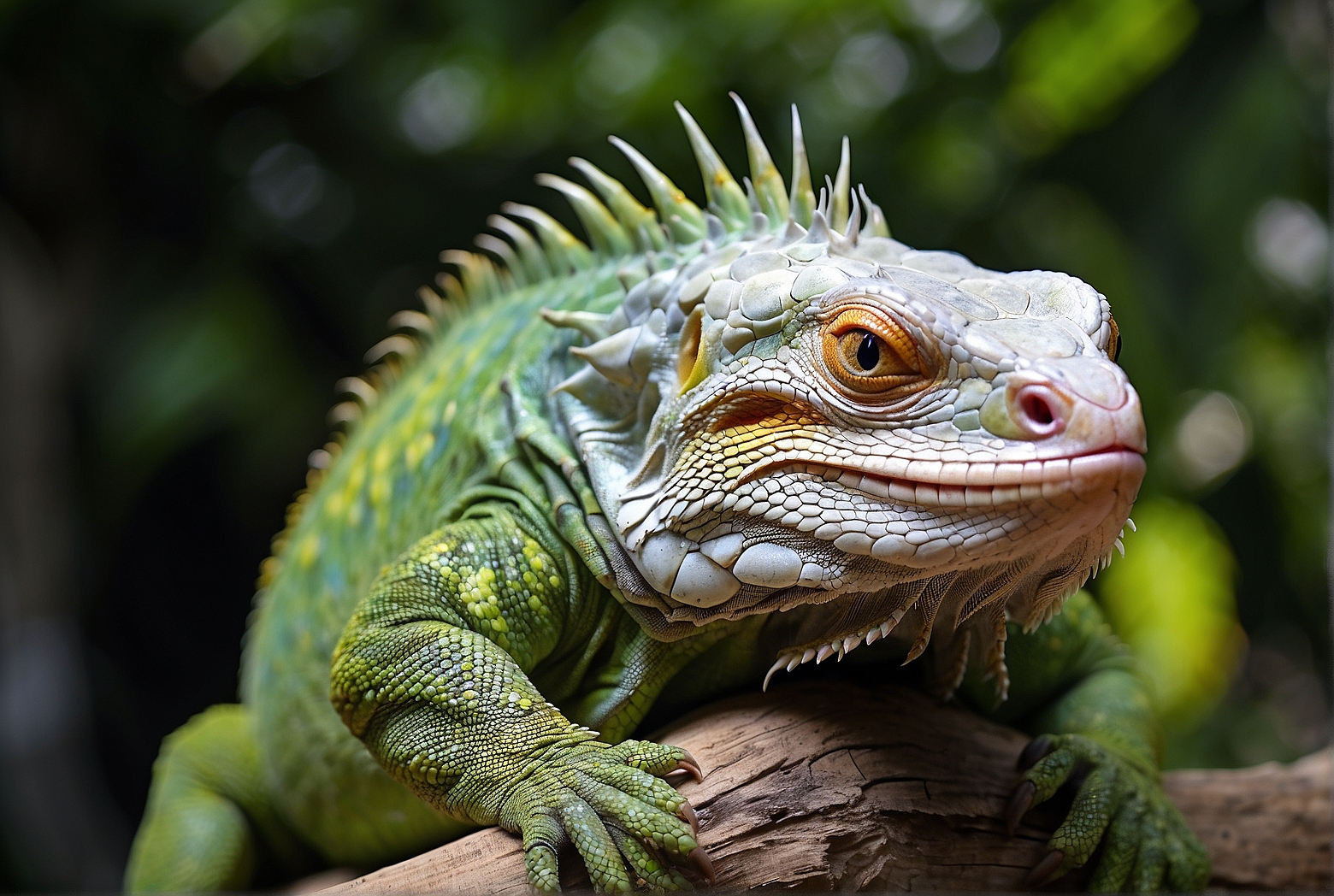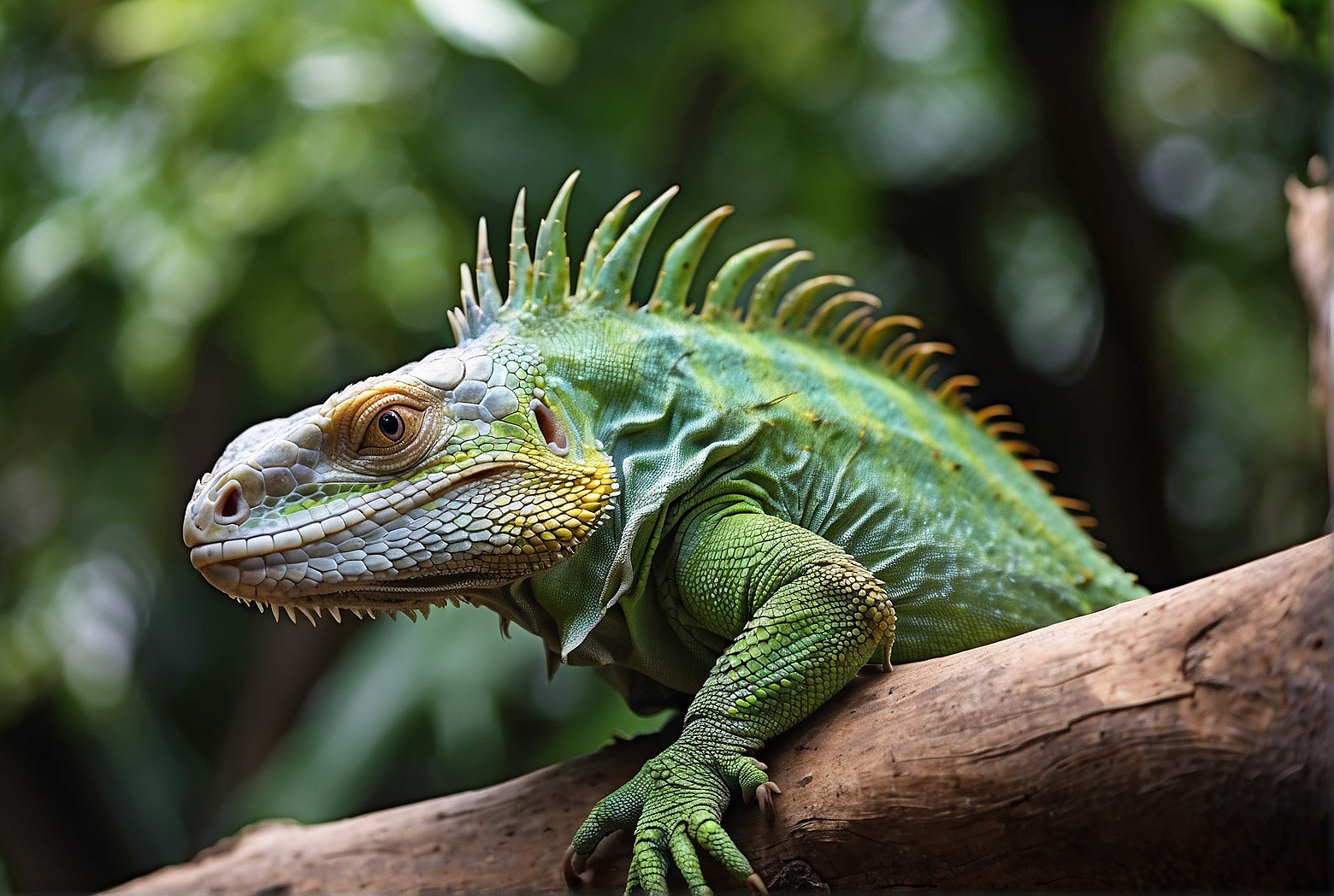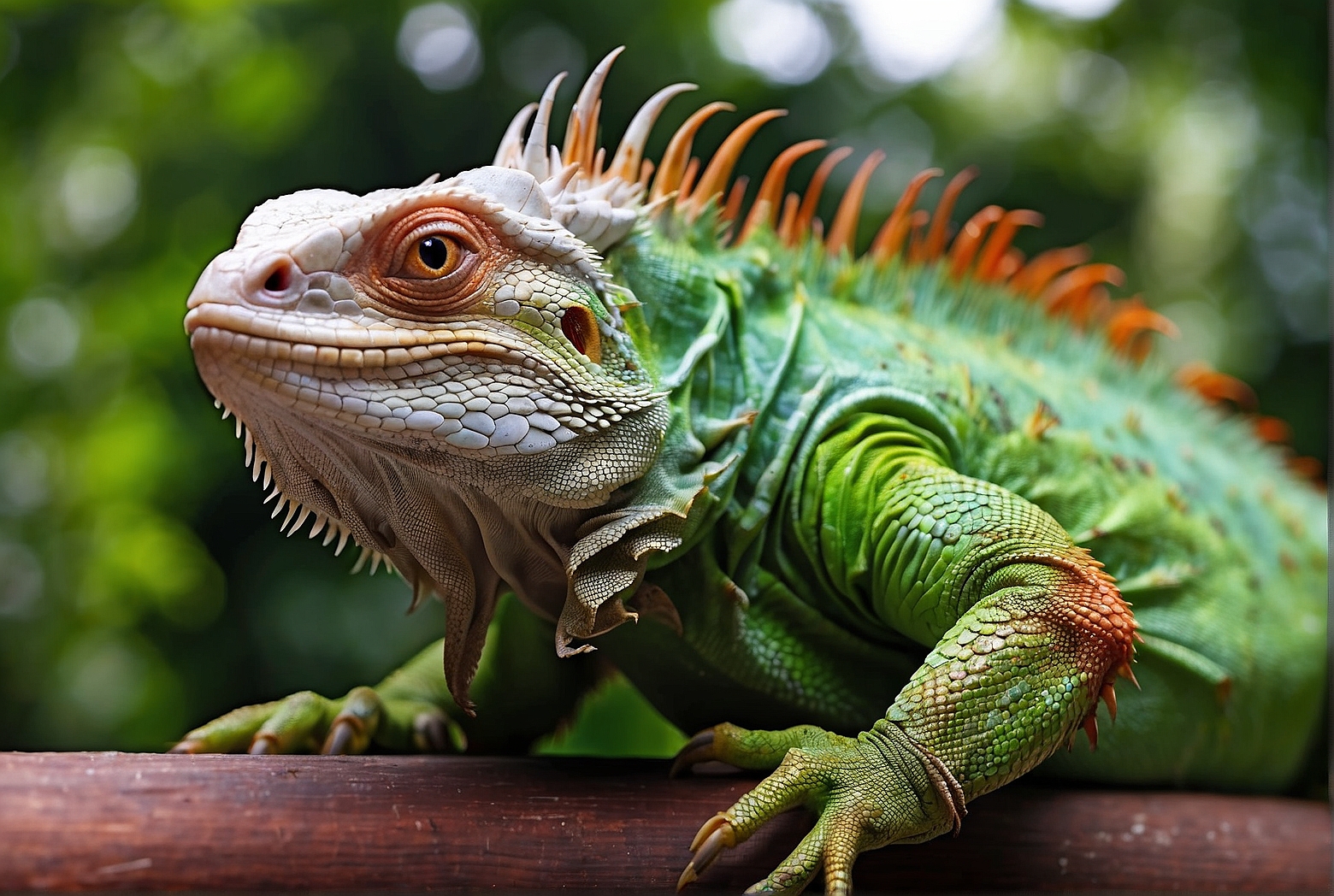If you’ve recently become the proud owner of a green iguana, you may be wondering how to properly care for your new scaly friend. Don’t worry, we’ve got you covered! In this ultimate guide, we’ll walk you through all the essentials of taking care of green iguanas, from creating the perfect habitat to providing them with a balanced diet. By the end of this article, you’ll have all the knowledge you need to ensure a happy and healthy life for your green iguana companion. So, let’s get started!
Housing Requirements
Enclosure size
When it comes to providing the best housing for your green iguana, enclosure size is of utmost importance. These active reptiles require ample space to move around and exercise. A suitable enclosure for an adult green iguana should be at least 6 feet tall, 6-8 feet long, and 3-4 feet wide. Younger iguanas can start in smaller enclosures but will eventually need the larger space as they grow. The enclosure should also be escape-proof, with secure locks and a sturdy design to prevent any accidental escapes.
Humidity and temperature
Maintaining the proper humidity and temperature in your iguana’s enclosure is crucial for their health. The humidity level should be around 60-70% to mimic their natural habitat. This can be achieved by misting the enclosure regularly and providing a large water bowl for them to soak in. A basking spot with a temperature of around 90-95°F should be provided, while the cooler side of the enclosure should be kept around 80°F. It’s important to monitor these levels using reliable thermometers and hygrometers.
Lighting and UVB requirements
Green iguanas rely on UVB light to synthesize Vitamin D3, which is essential for calcium absorption and overall bone health. Providing proper lighting is vital for their well-being. A UVB light with a strength of at least 5-10% should be placed in the enclosure, approximately 12-18 inches above the basking spot. This light should be replaced every 6-12 months, as its UVB output decreases over time. It’s also important to provide a day and night light cycle, ensuring your iguana has 12-14 hours of light and 10-12 hours of darkness each day.
Feeding and Diet
Vegetables and greens
Green iguanas are herbivores, and their diet should primarily consist of fresh vegetables and greens. Leafy greens such as collard greens, mustard greens, and dandelion greens are excellent choices. Other vegetables like bell peppers, squash, and zucchini can also be included. It’s important to provide a variety of these foods to ensure a balanced diet for your iguana. Aim to offer a mixture of different vegetables every day, and remember to wash them thoroughly to remove any pesticides.
Fruits
While fruits should be a smaller portion of your iguana’s diet, they can still be offered as occasional treats. Fruits like strawberries, mangoes, and blueberries can provide a tasty supplement to their regular vegetable intake. However, it’s crucial to remember that fruits are high in sugar and should be given sparingly to avoid any health issues.

Supplements and treats
To ensure your green iguana receives all the necessary nutrients, supplements are often recommended. Calcium and multivitamin supplements can be sprinkled on their food a few times a week. These supplements help maintain proper bone growth and overall health. Treats, such as edible flowers or freeze-dried insects, can also be given on occasion as a special reward for your iguana’s good behavior.
Handling and Socialization
Approaching an iguana
When approaching your green iguana, it’s important to do so calmly and confidently. Sudden movements or loud noises can startle them, causing stress or potential aggression. Approach from the side rather than directly from above, as this can mimic predatory behavior and make them feel threatened. Give your iguana time to observe you and approach on their own terms before attempting any handling.
Holding and supporting
When it comes to holding your green iguana, proper support is key. Never pick them up by their tail, as this can cause injury or stress. Instead, support their body with both hands, one underneath their chest and the other supporting their hindquarters. Keep a firm but gentle grip, ensuring they feel secure and comfortable in your hands. It’s important to note that not all green iguanas enjoy being held or may take time to become accustomed to it, so always respect their boundaries and comfort level.
Building trust and socializing
Building trust and socializing with your green iguana takes time and patience. Spend time near their enclosure, talking to them in a calm and reassuring tone. Offer treats or small pieces of their favorite vegetables as positive reinforcement. Avoid any sudden movements or loud noises that can startle them. With consistent interaction and positive experiences, your iguana will gradually become more comfortable with human presence and may even seek out social interaction with you.
Health and Veterinary Care
Signs of a healthy iguana
Regularly monitoring your green iguana’s health is crucial for detecting any signs of illness early. A healthy iguana should have clear, bright eyes, smooth skin, and a well-rounded body shape. They should be alert and active, displaying natural behaviors such as basking and exploring their enclosure. Their appetite should be strong, and their waste should be well-formed and consistent. If you notice any changes in behavior, appetite, or physical appearance, it’s essential to seek veterinary care promptly.
Common health issues
Like any living creature, green iguanas can experience various health issues. Some common health problems include metabolic bone disease, respiratory infections, parasites, and nutritional deficiencies. Metabolic bone disease, caused by a lack of proper calcium and UVB exposure, can lead to weak bones and deformities. Respiratory infections often occur due to poor environmental conditions, such as inadequate temperature or humidity levels. Regular veterinary check-ups and proper husbandry practices are key to preventing and addressing these health issues.

Finding a reptile veterinarian
Finding a reptile veterinarian experienced in treating green iguanas is essential for their well-being. Look for a veterinarian who specializes in exotic pets or reptiles. Ask for recommendations from fellow iguana owners or local reptile enthusiasts. It’s important to establish a relationship with a reptile veterinarian even before any health concerns arise. Regular check-ups and consultations with a knowledgeable veterinarian can help ensure your iguana receives the best possible care.
Cleaning and Maintenance
Cage cleaning
Regular cage cleaning is essential to maintain a healthy environment for your green iguana. Remove any feces or soiled bedding daily to prevent the build-up of bacteria. Thoroughly clean and disinfect the enclosure at least once a month, removing all decorations and providing a temporary holding area for your iguana. Use a reptile-safe cleaner and rinse the enclosure thoroughly before returning your iguana to their clean and safe habitat.
Substrate choices
Choosing the right substrate for your green iguana’s enclosure is important for their comfort and hygiene. Newspaper or reptile carpet can be used as a safe and easy-to-clean option. Avoid substrates like sand or loose particle bedding, as these can be ingested by your iguana and cause digestive issues. Ensure that the substrate is free of any harmful chemicals or toxins that could be dangerous to your iguana.
Maintaining humidity levels
Maintaining proper humidity levels in your green iguana’s enclosure is crucial for their health. Regular misting of the enclosure will help increase humidity levels, but it’s important to monitor these levels using a hygrometer. In addition to misting, providing a large water bowl for your iguana to soak in will also help maintain humidity. It’s important to strike a balance as overly high humidity can lead to respiratory issues, while low humidity can cause shedding problems. Monitoring and adjusting humidity levels as needed will ensure a comfortable and healthy environment for your iguana.
Creating an Enriching Environment
Proper cage decorations
Decorating your green iguana’s enclosure not only adds visual appeal but also provides important mental and physical stimulation. Choose decorations such as sturdy branches or logs that allow your iguana to climb and explore. Ensure that these decorations are securely placed, preventing any potential collapse or injury. Avoid using decorations with sharp edges or toxic materials that could harm your iguana.
Providing hiding spots
Green iguanas appreciate having hiding spots within their enclosure to retreat to when they need privacy or feel threatened. Use large, sturdy plants or specially-designed hiding caves to create safe and secure hiding spots. These hiding spots mimic their natural habitat and allow them to feel more comfortable and secure in their environment.
Including branches and perches
Including branches and perches within your green iguana’s enclosure encourages natural behaviors like climbing and basking. Choose sturdy branches that can support your iguana’s weight and securely attach them to the enclosure. These branches not only provide exercise opportunities but also give your iguana different vantage points to observe their surroundings. Remember to regularly inspect and clean the branches to ensure they remain safe and free of any hazards.
Breeding and Reproduction
Mating behaviors
Breeding green iguanas requires careful planning and consideration. Male iguanas become territorial and may display aggressive behaviors during the breeding season. Females also undergo significant hormonal changes and may become less tolerant of male advances. If you are considering breeding your iguanas, it is important to research and understand their unique mating behaviors and requirements fully. Ensure that you have suitable nesting sites and are prepared to provide care for any resulting hatchlings.
Creating a nesting site
For successful breeding, a suitable nesting site is necessary for female iguanas to lay their eggs. A nesting box filled with a mixture of soil, sand, and vermiculite provides the ideal substrate for egg laying. The nesting box should be deep enough for the female to bury her eggs, and it’s important to maintain proper temperature and humidity levels within the box. Proper nesting site preparation and monitoring are crucial to ensure the successful development of the eggs.
Incubating and hatching
Once the eggs have been laid, they need to be incubated under controlled conditions to ensure their development and hatching. The eggs should be carefully transferred to an incubator filled with a suitable incubation medium, such as vermiculite or perlite. The temperature and humidity within the incubator should be monitored and maintained at ideal levels. The incubation period for green iguana eggs typically ranges from 60 to 90 days. Close observation and patience are key during this critical stage of the breeding process.
Common Mistakes to Avoid
Improper diet
One of the most significant mistakes iguana owners can make is providing an improper diet. Green iguanas require a primarily herbivorous diet, consisting of fresh vegetables and greens, to meet their nutritional needs. Avoid feeding them too many fruits or foods high in sugar, as this can lead to obesity and other health issues. It’s crucial to research and understand their dietary requirements thoroughly and provide a varied and balanced diet to ensure their optimum health.
Inadequate lighting
Proper lighting, specifically UVB exposure, is crucial for green iguanas’ overall health and well-being. Many owners make the mistake of not providing adequate UVB lighting or neglecting to replace UVB bulbs regularly. Without sufficient UVB exposure, iguanas can develop metabolic bone disease and other related health issues. It’s important to invest in high-quality UVB bulbs, position them correctly within the enclosure, and replace them according to the manufacturer’s recommendations.
Ignoring signs of illness
Green iguanas are masters of hiding symptoms of illness, making it essential for owners to be vigilant and observant. Ignoring signs such as decreased appetite, lethargy, weight loss, or changes in behavior can result in delayed treatment and potentially life-threatening conditions for your iguana. Regularly observe your iguana’s behavior, monitor their appetite and waste, and seek veterinary care promptly at the first signs of any health concerns. Regular check-ups with a reptile veterinarian can also help identify any underlying health issues early on.
Legal Considerations
Checking local regulations
Before acquiring a green iguana, it’s crucial to check the local regulations regarding ownership of exotic pets. Some areas have specific laws or restrictions in place, which may require permits or licenses for keeping green iguanas. Familiarize yourself with these regulations to ensure you are in compliance with the law and able to provide the proper care for your iguana.
Permits and licenses
If permits or licenses are required in your area, be sure to obtain them before bringing home a green iguana. Research the specific requirements, fees, and processes involved in obtaining the necessary permits or licenses. Keep in mind that regulations can vary between different regions, so it’s important to double-check with the appropriate local authorities to ensure proper compliance.
Transportation regulations
When transporting green iguanas, it’s important to follow transportation regulations to ensure their safety and well-being. Whether you are traveling with your iguana locally or internationally, it’s important to research and understand the specific requirements and restrictions related to transportation. This may include guidelines for the type of enclosure used during transport, temperature requirements, and necessary documentation. Following these regulations will help ensure a stress-free journey for you and your iguana.
Rescue and Adoption Centers
Benefits of adopting
Considering adoption from a rescue or adoption center is a wonderful way to provide a loving home for a green iguana in need. Adopting a rescue iguana not only gives them a second chance at a happy life but also saves them from potential euthanasia or poor living conditions. Additionally, adoption centers often provide valuable guidance and support for new iguana owners, helping you navigate through the challenges of caring for your new companion.
Finding reputable centers
Finding reputable rescue and adoption centers is essential when considering adoption. Research local centers, read reviews, and ask for recommendations from fellow reptile enthusiasts. Reputable centers prioritize the well-being and welfare of their animals, providing proper care, rehabilitation, and support for potential adopters. Visit the center in person to observe their facilities and speak with staff to ensure they meet your expectations and share your values.
Proper adoption process
The adoption process at reputable centers usually involves an application, interview, and potentially a home visit to ensure you can provide a suitable environment for the iguana. Adoption fees may be required to cover the costs of caring for the iguanas at the center. During the adoption process, ask about the iguana’s history, temperament, and any specific care requirements. Centers often provide guidance and resources to help you successfully transition your new companion into their forever home.
